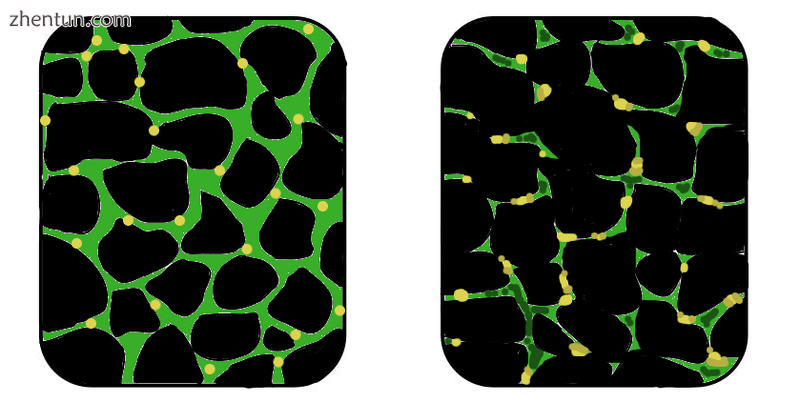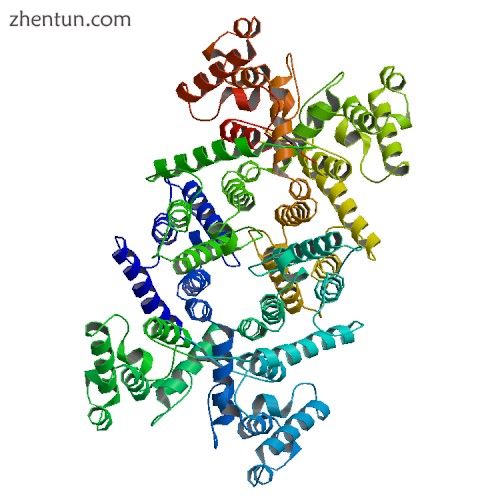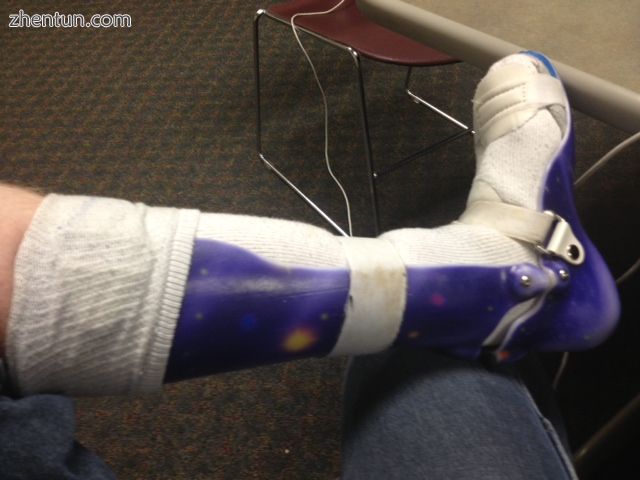肌营养不良症(MD)是一组肌肉疾病,随着时间的推移导致骨骼肌的减弱和衰弱[1]。这些疾病的不同之处主要在于肌肉受到影响,肌肉无力,肌肉加重的速度以及症状何时开始。[1]很多人最终都无法行走。[2]有些类型也与其他器官的问题有关。[2]
肌营养不良症组包含30种不同的遗传疾病,通常分为9大类或类型。[1] [2]最常见的类型是Duchenne肌营养不良症(DMD),通常影响男性从四岁开始。[1]其他类型包括Becker肌营养不良症,面肩肱型肌营养不良症和肌强直性营养不良。[1]它们是由于参与制造肌肉蛋白的基因突变所致。[2]这可能是由于遗传了父母的缺陷或早期发育过程中发生的突变所致。[2]紊乱可能是X连锁隐性遗传,常染色体隐性遗传或常染色体显性遗传。[2]诊断通常涉及血液检查和基因检测。[2]
肌肉萎缩症无法治愈。[1]物理治疗,牙套和矫正手术可能有助于解决某些症状。[1]呼吸肌无力的人可能需要辅助通气。[2]使用的药物包括用于减缓肌肉退化的类固醇,用于控制癫痫发作和一些肌肉活动的抗惊厥药,以及用于延迟对垂死肌肉细胞的损伤的免疫抑制剂。[1]结果取决于特定类型的疾病。[1]
Duchenne肌营养不良症占所有肌营养不良症病例的一半左右,在出生时影响约5,000名男性中的一名[2]。肌肉营养不良最早由Charles Bell在19世纪30年代描述。[2] “营养不良”这个词来自希腊语,意思是“困难”,而营养意味着“滋养”。[2]基因疗法作为一种治疗方法,正处于人类研究的早期阶段。[2]

在受影响的肌肉(右)中,与正常肌肉(左)相比,组织变得杂乱无章,肌营养不良蛋白(绿色)的浓度大大降低。
目录
1 症状和体征
2 原因
3 诊断
3.1 分类
4 管理
5 预后
6 历史
7 研究
8 参考
体征和症状
与肌营养不良症一致的症状和体征是:[3]
进行性肌肉萎缩
平衡不佳
脊柱侧凸(脊柱和背部弯曲)
渐进无法行走
蹒跚步态
小腿变形
运动范围有限
呼吸困难
心肌病
肌肉痉挛
Gowers' 标志
原因

抗肌萎缩蛋白
这些病症通常是遗传的,并且不同的肌营养不良症遵循各种遗传模式。肌肉营养不良可被个体遗传为X连锁疾病,隐性或显性疾病。此外,它可以是自发突变,这意味着DNA复制和自发病变的错误。自发性病变是由于DNA的自然损伤,其中最常见的是脱嘌呤和脱氨。[4] [5]
抗肌萎缩蛋白在肌纤维膜中发现;它的螺旋性使它可以像弹簧或减震器一样工作。抗肌萎缩蛋白将肌动蛋白与肌细胞质膜的细胞骨架和抗糖聚糖连接起来,称为肌纤维膜(细胞外)。除了机械稳定,肌营养不良蛋白还可以调节钙水平。[6] [7]
最近关于蛋白质与错义突变及其邻居相互作用的研究表明,与参与蛋白质结合的中心蛋白质相关的高度刚性和具有与钙有关的分子功能的灵活子网络[8]。
诊断
肌营养不良症的诊断基于肌肉活检结果,肌酸磷酸激酶(CpK3)增加,肌电图和基因检测。体格检查和患者的病史将帮助医生确定肌营养不良的类型。特定的肌肉群受到不同类型的肌营养不良症的影响。[9]
其他可以做的测试是胸部X光,超声心动图,CT扫描和磁共振图像扫描,通过磁场可以产生图像,其细节有助于诊断肌营养不良。[10]生活质量可以使用特定的问卷来衡量。[11]
管理

踝足矫形器
目前,肌肉萎缩症尚无法治愈。在管理,物理治疗,职业治疗,矫形干预(例如,踝足矫形器),[29] [30]言语治疗和呼吸治疗方面可能会有所帮助。[29]低强度皮质类固醇,如泼尼松和地夫可,有助于维持肌肉张力。[31]在某些情况下,可能需要矫形器(用于支撑的矫形器具)和矫正整形外科手术以改善生活质量。[2] EDMD和肌强直性肌营养不良症可能需要心脏起搏器。[32]在肌强直性肌营养不良中发生的肌强直(强烈收缩后肌肉的延迟松弛)可以用奎宁等药物治疗[33]。
职业治疗帮助患有MD的个体在尽可能最独立的水平上从事日常生活活动(例如自我喂养和自我护理活动)和休闲活动。这可以通过使用自适应设备或使用节能技术来实现。职业治疗可以在家庭或工作中实现对个人环境的改变,以增加个人的功能和可及性;此外,它还涉及可能伴随医学博士的社会心理变化和认知能力下降,并为家庭和个人提供有关疾病的支持和教育。[34]
预测
预后取决于MD的个体形式。在某些情况下,患有肌肉疾病的人将逐渐变弱,以至于由于心脏和呼吸并发症而缩短寿命。然而,一些肌肉疾病根本不会影响预期寿命,正在进行的研究试图寻找治疗方法来缓解肌肉无力。[2]
历史
在19世纪60年代,对医学期刊中逐渐变弱,失去行走能力和早年死亡的男孩的描述变得更加突出。在接下来的十年中,[35]法国神经病学家Guillaume Duchenne全面介绍了这种疾病的最常见和最严重的形式,现在他的名字是Duchenne MD。
研究
世卫组织国际组织于2012年在英国进行了关于MD的最佳类固醇方案的试验。[36]在美国的研究方面,主要由联邦资助的组织专注于肌肉萎缩症研究,包括基因治疗和再生医学,是国家神经疾病和中风研究所,国家关节炎和肌肉骨骼和皮肤病研究所,以及国家儿童健康与人类发展研究所。[12]
1966年,肌肉营养不良协会开始了它的年度杰瑞·刘易斯MDA电视节目,它可能比其他任何事件或倡议更多地提高对肌肉萎缩症的认识。然而,残疾人权利倡导者批评电视节目将该疾病的受害者描绘为值得怜悯而不是尊重。[37]
2001年12月18日,MD CARE法案在美国签署成为法律;它修订了“公共卫生服务法”,为各种肌肉营养不良提供研究。该法还建立了肌肉萎缩症协调委员会,通过一致的研究策略帮助集中研究工作。[38] [39]
另见
Emery–Dreifuss muscular dystrophy
Fukuyama congenital muscular dystrophy
Muscle hypertrophy
Muscular Dystrophy UK
Muscular Dystrophy Canada
Muscular Dystrophy Family Foundation
参考
"NINDS Muscular Dystrophy Information Page". NINDS. March 4, 2016. Archived from the original on 30 July 2016. Retrieved 12 September 2016.
"Muscular Dystrophy: Hope Through Research". NINDS. March 4, 2016. Archived from the original on 30 September 2016. Retrieved 12 September 2016.
Muscular Dystrophy Clinical Presentation at eMedicine
Choices, NHS. "Muscular dystrophy - Causes - NHS Choices". www.nhs.uk. Archived from the original on 2016-04-02. Retrieved 2016-04-10.
Griffiths, Anthony JF; Miller, Jeffrey H.; Suzuki, David T.; Lewontin, Richard C.; Gelbart, William M. (2000-01-01). "Spontaneous mutations". Archived from the original on 2017-04-02.
"DMD gene". Genetics Home Reference. 2016-03-28. Archived from the original on 2016-04-16. Retrieved 2016-04-10.
Lapidos, Karen A.; Kakkar, Rahul; McNally, Elizabeth M. (2004-04-30). "The Dystrophin Glycoprotein Complex Signaling Strength and Integrity for the Sarcolemma". Circulation Research. 94 (8): 1023–1031. doi:10.1161/01.RES.0000126574.61061.25. ISSN 0009-7330. PMID 15117830. Archived from the original on 2016-05-25.
Sharma, Ankush (2014). "Publication:Rigidity and flexibility in protein-protein interaction networks: a case study on neuromuscular disorders". www.openaire.eu. Archived from the original on 22 April 2016. Retrieved 10 April 2016.
"NIH /How is muscular dystrophy diagnosed?". NIH.gov. NIH. 2015. Archived from the original on 7 April 2016. Retrieved 10 April 2016.
"Diagnosis Muscular Dystrophy". NHS Choices. NHS.uk. 2015. Archived from the original on 19 April 2016. Retrieved 10 April 2016.
Dany, Antoine; Barbe, Coralie; Rapin, Amandine; Réveillère, Christian; Hardouin, Jean-Benoit; Morrone, Isabella; Wolak-Thierry, Aurore; Dramé, Moustapha; Calmus, Arnaud; Sacconi, Sabrina; Bassez, Guillaume; Tiffreau, Vincent; Richard, Isabelle; Gallais, Benjamin; Prigent, Hélène; Taiar, Redha; Jolly, Damien; Novella, Jean-Luc; Boyer, François Constant (2015). "Construction of a Quality of Life Questionnaire for slowly progressive neuromuscular disease". Quality of Life Research. 24 (11): 2615–2623. doi:10.1007/s11136-015-1013-8. ISSN 0962-9343. PMID 26141500.
May 2006 report to Congress Archived 2014-04-05 at the Wayback Machine on Implementation of the MD CARE Act, as submitted by Department of Health and Human Service's National Institutes of Health
"Becker muscular dystrophy: MedlinePlus Medical Encyclopedia". medlineplus.gov. Archived from the original on 15 March 2017. Retrieved 14 March 2017.
Congenital Muscular Dystrophy~clinical at eMedicine
"Duchenne muscular dystrophy: MedlinePlus Medical Encyclopedia". medlineplus.gov. Archived from the original on 2017-04-05. Retrieved 2017-03-14.
"Duchenne and Becker muscular dystrophy - Genetics Home Reference". Ghr.nlm.nih.gov. 2017-03-07. Archived from the original on 2017-03-24. Retrieved 2017-03-14.
"Duchenne Muscular Dystrophy. What is muscular dystrophy? | Patient". Patient.info. 2016-04-15. Archived from the original on 2016-12-02. Retrieved 2017-03-14.
Udd, Bjarne (2011). Distal muscular dystrophies. Handbook of Clinical Neurology. 101. pp. 239–62. doi:10.1016/B978-0-08-045031-5.00016-5. ISBN 9780080450315. PMID 21496636.
"OMIM Entry - # 310300 - EMERY-DREIFUSS MUSCULAR DYSTROPHY 1, X-LINKED; EDMD1". Omim.org. Archived from the original on 2017-03-10. Retrieved 2017-03-14.
"Emery-Dreifuss muscular dystrophy - Genetics Home Reference". Ghr.nlm.nih.gov. 2017-03-07. Archived from the original on 2017-03-12. Retrieved 2017-03-14.
Emery–Dreifuss Muscular Dystrophy at eMedicine
"facioscapulohumeral muscular dystrophy - Genetics Home Reference". Ghr.nlm.nih.gov. Archived from the original on 2017-03-24. Retrieved 2017-03-14.
Rosenberg, Roger N.; Pascual, Juan M. (2014-10-28). Rosenberg's Molecular and Genetic Basis of Neurological and Psychiatric Disease. p. 1174. ISBN 978-0124105492. Archived from the original on 2017-03-15. Retrieved 2017-03-14.
"Facioscapulohumeral muscular dystrophy: MedlinePlus Medical Encyclopedia". Nlm.nih.gov. 2017-03-09. Archived from the original on 2016-07-04. Retrieved 2017-03-14.
Pegoraro, E; Hoffman, EP; Adam, MP; Ardinger, HH; Pagon, RA; Wallace, SE; Bean, LJH; Stephens, K; Amemiya, A (2012). "Limb-Girdle Muscular Dystrophy Overview". PMID 20301582.
Jenkins, Simon P.R. (2005). Sports Science Handbook:I - Z. Brentwood, Essex: Multi-Science Publ. Co. p. 121. ISBN 978-0906522-37-0.
Turner, C.; Hilton-Jones, D. (2010). "The myotonic dystrophies: diagnosis and management" (PDF). Journal of Neurology, Neurosurgery & Psychiatry. 81 (4): 358–67. doi:10.1136/jnnp.2008.158261. PMID 20176601.
"Myotonic Dystrophy Type 1". Myotonic Dystrophy Type 1 - GeneReviews® - NCBI Bookshelf. Ncbi.nlm.nih.gov. University of Washington, Seattle. 1993. Archived from the original on 2017-01-18. Retrieved 2017-03-14.
"What are the treatments for muscular dystrophy?". NIH.gov. NIH. 2015. Archived from the original on 7 April 2016. Retrieved 10 April 2016.
"Muscular Dystrophy-OrthoInfo - AAOS". orthoinfo.aaos.org. Archived from the original on 2016-04-12. Retrieved 2016-04-10.
McADAM, LAURA C.; MAYO, AMANDA L.; ALMAN, BENJAMIN A.; BIGGAR, W. DOUGLAS (2012-05-01). "The Canadian experience with long term deflazacort treatment in Duchenne muscular dystrophy". Acta Myologica. 31 (1): 16–20. ISSN 1128-2460. PMC 3440807. PMID 22655512.
Verhaert, David; Richards, Kathryn; Rafael-Fortney, Jill A.; Raman, Subha V. (2011-01-01). "Cardiac Involvement in Patients with Muscular Dystrophies: Magnetic Resonance Imaging Phenotype and Genotypic Considerations". Circulation: Cardiovascular Imaging. 4 (1): 67–76. doi:10.1161/CIRCIMAGING.110.960740. ISSN 1941-9651. PMC 3057042. PMID 21245364.
Eddy, Linda L. (2013-01-25). Caring for Children with Special Healthcare Needs and Their Families: A Handbook for Healthcare Professionals. John Wiley & Sons. ISBN 9781118517970. Archived from the original on 2017-01-06.
Lehman, R. M.; McCormack, G. L. (2001). "Neurogenic and Myopathic Dysfunction". In Pedretti, Lorraine Williams; Early, Mary Beth. Occupational Therapy: Practice Skills for Physical Dysfunction (5th ed.). Mosby. pp. 802–3. ISBN 978-0-323-00765-8.
Laing, Nigel G; Davis, Mark R; Bayley, Klair; Fletcher, Sue; Wilton, Steve D (2011-08-01). "Molecular Diagnosis of Duchenne Muscular Dystrophy: Past, Present and Future in Relation to Implementing Therapies". The Clinical Biochemist Reviews. 32 (3): 129–134. ISSN 0159-8090. PMC 3157948. PMID 21912442.
Choices, N. H. S. (2011-11-09). "Muscular Dystrophy - Clinical trial details - NHS Choices". Archived from the original on 2016-04-21. Retrieved 2016-04-10.
Berman, Ari (2011-09-02). "The End of the Jerry Lewis Telethon—It's About Time". The Nation. Retrieved 2017-03-14.
H.R. 717--107th Congress (2001) Archived 2012-02-19 at the Wayback Machine: MD-CARE Act, GovTrack.us (database of federal legislation), (accessed Jul 29, 2007)
Public Law 107-84 Archived 2012-11-07 at the Wayback Machine, PDF as retrieved from NIH website |